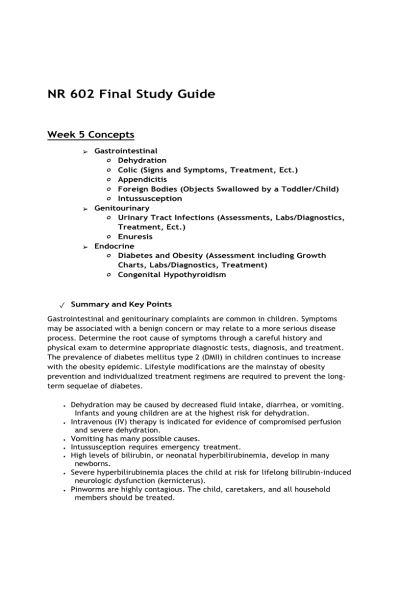Document Preview
Week 5 Concepts
- Gastrointestinal
- Dehydration
- Colic (Signs and Symptoms, Treatment, Ect.)
- Appendicitis
- Foreign Bodies (Objects Swallowed by a Toddler/Child)
- Intussusception
- Genitourinary
- Urinary Tract Infections (Assessments, Labs/Diagnostics, Treatment, Ect.)
- Enuresis
- Endocrine
- Diabetes and Obesity (Assessment including Growth Charts, Labs/Diagnostics, Treatment)
- Congenital Hypothyroidism
- Summary and Key Points
Gastrointestinal and genitourinary complaints are common in children. Symptoms may be associated with a benign concern or may relate to a more serious disease process. Determine the root cause of symptoms through a careful history and physical exam to determine appropriate diagnostic tests, diagnosis, and treatment. The prevalence of diabetes mellitus type 2 (DMII) in children continues to increase with the obesity epidemic. Lifestyle modifications are the mainstay of obesity prevention and individualized treatment regimens are required to prevent the long- term sequelae of diabetes.
- Dehydration may be caused by decreased fluid intake, diarrhea, or vomiting. Infants and young children are at the highest risk for dehydration.
- Intravenous (IV) therapy is indicated for evidence of compromised perfusion and severe dehydration.
- Vomiting has many possible causes.
- Intussusception requires emergency treatment.
- High levels of bilirubin, or neonatal hyperbilirubinemia, develop in many newborns.
- Severe hyperbilirubinemia places the child at risk for lifelong bilirubin-induced neurologic dysfunction (kernicterus).
- Pinworms are highly contagious. The child, caretakers, and all household members should be treated.
- Constipation is rarely a serious condition, but it can be a symptom of other diseases.
- Encopresis is repeated, voluntary or involuntary, defecation in inappropriate places.
- Enuresis can be monosymptomatic or non-monosymptomatic.
- Uncomplicated urinary tract infections (UTIs) and bacterial cystitis can be treated with amoxicillin, trimethoprim-sulfamethoxazole, or a first- generation cephalosporin.
- Sexual abuse in young children often leaves no physical evidence.
- Diabetes mellitus type 1 (DMI) is typically diagnosed in childhood. The incidence of DMII in children and adolescents has increased dramatically with the obesity epidemic.
- Growth and development must be considered in developing a diabetic treatment plan.
- Diabetic ketoacidosis requires immediate hospitalization for IV insulin and fluid replacement to prevent cerebral edema.
- Childhood obesity increases the individual's risk for acute and chronic physical and psychological health concerns.
- Body mass index (BMI) provides an approximate figure from which obesity can be estimated; BMI is calculated in children based on age and gender.
- Healthy nutrition and activity should be encouraged at the family level……….. Continue
| Instituition / Term | |
| Term | Spring Session |
| Institution | Chamberlain |
| Contributor | Christie |

/Pediatric Primary Care (Self Made)-80x80.png)
-80x80.png)


















































